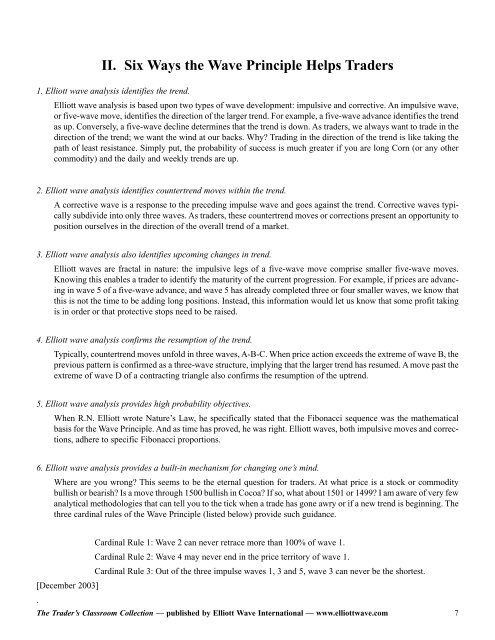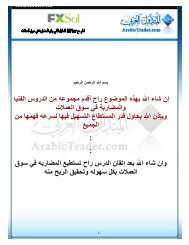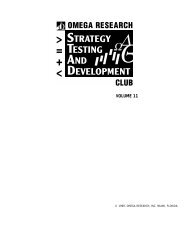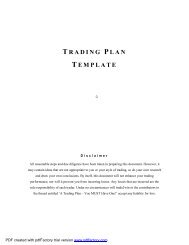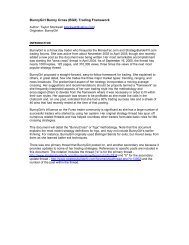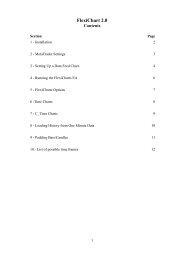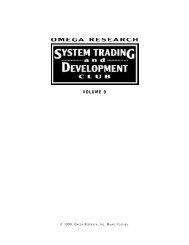the trader's classroom collection
the trader's classroom collection
the trader's classroom collection
You also want an ePaper? Increase the reach of your titles
YUMPU automatically turns print PDFs into web optimized ePapers that Google loves.
II. Six Ways <strong>the</strong> Wave Principle Helps Traders<br />
1. Elliott wave analysis identifies <strong>the</strong> trend.<br />
Elliott wave analysis is based upon two types of wave development: impulsive and corrective. An impulsive wave,<br />
or five-wave move, identifies <strong>the</strong> direction of <strong>the</strong> larger trend. For example, a five-wave advance identifies <strong>the</strong> trend<br />
as up. Conversely, a five-wave decline determines that <strong>the</strong> trend is down. As traders, we always want to trade in <strong>the</strong><br />
direction of <strong>the</strong> trend; we want <strong>the</strong> wind at our backs. Why? Trading in <strong>the</strong> direction of <strong>the</strong> trend is like taking <strong>the</strong><br />
path of least resistance. Simply put, <strong>the</strong> probability of success is much greater if you are long Corn (or any o<strong>the</strong>r<br />
commodity) and <strong>the</strong> daily and weekly trends are up.<br />
2. Elliott wave analysis identifies countertrend moves within <strong>the</strong> trend.<br />
A corrective wave is a response to <strong>the</strong> preceding impulse wave and goes against <strong>the</strong> trend. Corrective waves typically<br />
subdivide into only three waves. As traders, <strong>the</strong>se countertrend moves or corrections present an opportunity to<br />
position ourselves in <strong>the</strong> direction of <strong>the</strong> overall trend of a market.<br />
3. Elliott wave analysis also identifies upcoming changes in trend.<br />
Elliott waves are fractal in nature: <strong>the</strong> impulsive legs of a five-wave move comprise smaller five-wave moves.<br />
Knowing this enables a trader to identify <strong>the</strong> maturity of <strong>the</strong> current progression. For example, if prices are advancing<br />
in wave 5 of a five-wave advance, and wave 5 has already completed three or four smaller waves, we know that<br />
this is not <strong>the</strong> time to be adding long positions. Instead, this information would let us know that some profit taking<br />
is in order or that protective stops need to be raised.<br />
4. Elliott wave analysis confirms <strong>the</strong> resumption of <strong>the</strong> trend.<br />
Typically, countertrend moves unfold in three waves, A-B-C. When price action exceeds <strong>the</strong> extreme of wave B, <strong>the</strong><br />
previous pattern is confirmed as a three-wave structure, implying that <strong>the</strong> larger trend has resumed. A move past <strong>the</strong><br />
extreme of wave D of a contracting triangle also confirms <strong>the</strong> resumption of <strong>the</strong> uptrend.<br />
5. Elliott wave analysis provides high probability objectives.<br />
When R.N. Elliott wrote Nature’s Law, he specifically stated that <strong>the</strong> Fibonacci sequence was <strong>the</strong> ma<strong>the</strong>matical<br />
basis for <strong>the</strong> Wave Principle. And as time has proved, he was right. Elliott waves, both impulsive moves and corrections,<br />
adhere to specific Fibonacci proportions.<br />
6. Elliott wave analysis provides a built-in mechanism for changing one’s mind.<br />
Where are you wrong? This seems to be <strong>the</strong> eternal question for traders. At what price is a stock or commodity<br />
bullish or bearish? Is a move through 1500 bullish in Cocoa? If so, what about 1501 or 1499? I am aware of very few<br />
analytical methodologies that can tell you to <strong>the</strong> tick when a trade has gone awry or if a new trend is beginning. The<br />
three cardinal rules of <strong>the</strong> Wave Principle (listed below) provide such guidance.<br />
Cardinal Rule 1: Wave 2 can never retrace more than 100% of wave 1.<br />
Cardinal Rule 2: Wave 4 may never end in <strong>the</strong> price territory of wave 1.<br />
Cardinal Rule 3: Out of <strong>the</strong> three impulse waves 1, 3 and 5, wave 3 can never be <strong>the</strong> shortest.<br />
[December 2003]<br />
.<br />
The Trader’s Classroom Collection — published by Elliott Wave International — www.elliottwave.com<br />
7


